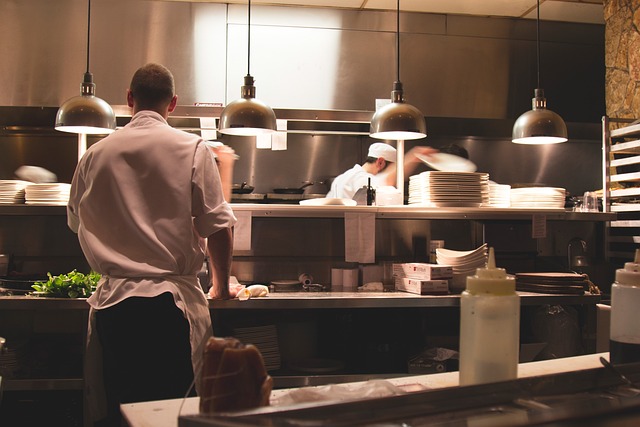
Welcome to the restaurant kitchen, the center of culinary excellence. In this extensive guide, we will take you on a tour of the essential elements of restaurant kitchen cleaning and reveal the crucial role it plays in maintaining hygiene standards. From the careful cleaning procedures to the thoughtful layout of the kitchen, each section will give you in-depth knowledge about everything you require to guarantee a clean and hygienic environment in your restaurant kitchen.
See also our post on Zero-Waste Kitchen Cleaning: Sustainable Solutions for Spills and Stains
The Foundation of Hygiene
Understanding Microbial Risks
Understanding microbiological risks is critical in the busy world of a restaurant kitchen. Bacteria, viruses, and other pathogens can proliferate in kitchen environments, posing health risks to patrons as well as staff. A solid understanding of these risks is necessary to establish effective cleaning practices.
Implementing Food Safety Protocols
Implementing stringent food safety protocols is a cornerstone of maintaining kitchen hygiene. Adhering to established guidelines for food handling, storage, and preparation minimizes the risk of contamination and ensures that the dishes leaving your kitchen are not only delicious but safe for consumption.
The Importance of Cross-Contamination Prevention
Cross-contamination can be a silent but potent threat in a restaurant kitchen. Detailed measures, such as using color-coded cutting boards and utensils for different food types, help prevent cross-contamination and maintain the integrity of your ingredients.
Regular Health and Safety Training
Regular health and safety training for kitchen staff is essential. Educating your team on the importance of cleanliness, proper hygiene practices, and the potential risks associated with neglecting these aspects establishes a culture of responsibility and awareness in the kitchen.
Investment in Quality Cleaning Supplies
Investing in high-quality cleaning supplies is a fundamental step in maintaining kitchen hygiene. From effective sanitizers to durable scrubbers, having the right tools at your disposal ensures that your cleaning efforts yield optimal results.
Daily Cleaning Routines
Thorough Cleaning of Surfaces
Daily cleaning routines begin with the thorough cleaning of surfaces. Countertops, prep tables, and cooking surfaces should be cleaned and sanitized regularly to eliminate any lingering bacteria and prevent the accumulation of dirt and grime.
Daily Floor Maintenance
Daily floor maintenance is a non-negotiable. The kitchen floor bears the brunt of spills, foot traffic, and dropped ingredients. Regular sweeping, mopping, and attention to floor drains help maintain a safe and clean kitchen environment.
Sanitizing Cooking Equipment
Sanitizing cooking equipment is a crucial step in daily routines. Grills, ovens, fryers, and other cooking appliances should be regularly cleaned and sanitized to prevent the buildup of grease and bacteria, ensuring that each dish is prepared in a clean environment.
Cleaning and Organizing Storage Areas
Storage areas, including walk-in refrigerators and dry storage spaces, should be cleaned and organized daily. Proper labeling, rotation of stock, and attention to cleanliness in storage areas contribute to overall kitchen hygiene.
Inspecting and Cleaning Ventilation Systems
Ventilation systems play a vital role in maintaining air quality in the kitchen. Regular inspection and cleaning of exhaust hoods and ducts prevent the buildup of grease and ensure that the kitchen remains a comfortable and safe workspace.
See also our post on The Art of Eco-Friendly Dishwashing: Green Practices in the Kitchen
Weekly Deep Cleaning Practices
Disassembling and Cleaning Kitchen Equipment
Weekly deep cleaning practices involve the disassembly and thorough cleaning of kitchen equipment. From slicers and mixers to blenders and grinders, ensuring that each component is cleaned and sanitized prevents hidden pockets of bacteria.
Deep Cleaning of Cooking Appliances
Cooking appliances, such as deep fryers and grills, require deeper attention on a weekly basis. Removing built-up grease, carbon deposits, and food residues not only enhances the efficiency of the equipment but also contributes to a safer cooking environment.
Detailed Cleaning of Storage Shelves and Racks
Storage shelves and racks, often overlooked in daily routines, should be detailed cleaned weekly. Removing items, wiping down surfaces, and addressing any spills or residues contribute to a more organized and hygienic storage area.
Cleaning and Sanitizing Dishwashing Areas
Dishwashing areas are a hub for cleanliness but can also be a breeding ground for bacteria. Weekly deep cleaning involves the thorough cleaning and sanitization of dishwashing equipment, ensuring that utensils and dishes emerge from the process truly clean.
Inspection and Replacement of Kitchen Linens
Kitchen linens, including towels and aprons, should be inspected and replaced weekly. Dirty or worn-out linens can harbor bacteria and compromise hygiene standards, making regular inspection and replacement a key aspect of kitchen cleanliness.
Monthly Maintenance
Thorough Inspection of Kitchen Plumbing
Monthly maintenance includes a thorough inspection of kitchen plumbing. Checking for leaks, addressing any drainage issues, and ensuring that water flows freely contribute to a smoothly functioning kitchen and prevent potential hygiene hazards.
Professional Inspection of Ventilation Systems
While weekly cleaning of ventilation systems is crucial, a monthly professional inspection ensures that every component is functioning optimally. This proactive approach prevents potential fire hazards and maintains a healthy kitchen environment.
Cleaning and Disinfecting Storage Containers
Storage containers, especially those used for food ingredients, should be cleaned and disinfected monthly. This practice eliminates any lingering residues and prevents the risk of cross-contamination between different batches of ingredients.
Review and Updating of Cleaning Protocols
Monthly maintenance provides an opportunity to review and update cleaning protocols. As kitchen operations evolve, ensuring that cleaning practices align with the current needs of the restaurant helps maintain consistent hygiene standards.
Training Refresher for Kitchen Staff
A monthly training refresher for kitchen staff reinforces the importance of hygiene practices. Covering topics such as proper handwashing techniques, the use of protective gear, and adherence to cleaning protocols keeps the team vigilant and informed.
See also our post on Cleaning Hacks for Busy Parents: Managing a Clean Home with Kids
Customizing Cleaning Schedules
Tailoring Cleaning Schedules to Kitchen Size
Customizing cleaning schedules involves tailoring routines to the size of the kitchen. Larger kitchens may require more extensive cleaning routines, while smaller spaces can focus on targeted and efficient cleaning practices.
Adapting Cleaning Schedules to Cuisine Type
The type of cuisine served influences cleaning requirements. For example, kitchens that handle raw meat may need more frequent and thorough cleaning compared to vegetarian kitchens. Adapting schedules to cuisine type ensures that cleaning efforts align with specific risks.
Considering Peak Operational Hours
Cleaning schedules should consider peak operational hours. Finding the right balance between maintaining cleanliness and accommodating the demands of busy service hours ensures that kitchen hygiene remains a priority without disrupting the flow of operations.
Incorporating Seasonal Considerations
Seasonal changes can impact kitchen hygiene. For example, summer heat may necessitate more frequent cleaning of refrigeration units. Incorporating seasonal considerations into cleaning schedules helps address specific challenges that arise with changing weather conditions.
Regular Review and Adjustment of Schedules
Regularly reviewing and adjusting cleaning schedules is essential. As the restaurant evolves, shifts in menu offerings, customer demands, and kitchen staff may require modifications to ensure that cleaning practices remain effective and aligned with business needs.
Staff Training and Accountability
Comprehensive Training Programs
Implementing comprehensive training programs is foundational for maintaining kitchen hygiene. From onboarding new staff to regular training sessions, ensuring that each team member understands and follows proper cleaning protocols is crucial.
Accountability Measures for Kitchen Staff
Establishing accountability measures for kitchen staff reinforces the importance of cleanliness. This includes monitoring adherence to cleaning schedules, conducting spot checks, and recognizing and addressing any deviations from established protocols.
Creating a Culture of Responsibility
Creating a culture of responsibility involves instilling a sense of ownership in every team member. When each staff member recognizes their role in maintaining kitchen hygiene, a collective effort emerges, contributing to a cleaner and healthier workspace.
Regular Performance Assessments
Conducting regular performance assessments ensures that each staff member’s contribution to kitchen hygiene is recognized and addressed. This feedback loop fosters continuous improvement and reinforces the importance of cleanliness in daily operations.
Open Communication Channels
Open communication channels between kitchen staff and management are vital. Encouraging staff to report any hygiene concerns or suggest improvements creates a collaborative environment where everyone is invested in maintaining a clean and safe kitchen.
See also our post on How to Properly Clean and Disinfect the Kitchen Sink
Responding to Hygiene Challenges
Swift Response to Spills and Accidents
Swift response to spills and accidents is critical. Establishing protocols for immediate cleanup and addressing spills promptly prevents the spread of contaminants and maintains a safe kitchen environment.
Periodic Professional Inspections
Periodic professional inspections supplement daily and weekly cleaning efforts. Bringing in experts to conduct thorough assessments ensures that potential hygiene challenges are identified and addressed proactively.
Investigation and Resolution of Complaints
Investigating and resolving hygiene-related complaints is part of maintaining a positive dining experience. A prompt and thorough investigation, along with corrective actions, demonstrates a commitment to customer satisfaction and kitchen cleanliness.
Continuous Training on Emerging Hygiene Trends
Continuous training on emerging hygiene trends keeps the kitchen staff informed about the latest developments in food safety and cleanliness. Staying ahead of industry trends ensures that the restaurant remains at the forefront of hygiene standards.
Collaboration with Professional Cleaning Services
Collaborating with professional cleaning services is a strategic approach to addressing hygiene challenges. Periodic deep cleaning sessions conducted by experts complement daily routines, ensuring that every nook and cranny is thoroughly cleaned.
See also our post on Sustainable Office Cleaning: Green Practices for a Productive Workspace
Conclusion
This guide, a comprehensive exploration of restaurant kitchen cleaning, has unveiled the layers of diligence required to maintain impeccable hygiene standards. From daily routines to monthly maintenance, customized schedules, staff training, and addressing hygiene challenges, each section has provided nuanced insights into the multifaceted world of kitchen cleanliness. Let hygiene standards be the unsung hero that makes sure every dish served is not only delicious but prepared in a kitchen that values cleanliness as an integral ingredient. As you navigate the complex dance of maintaining a hygienic restaurant kitchen, may this guide empower you to orchestrate a space where culinary excellence and cleanliness coexist harmoniously.







